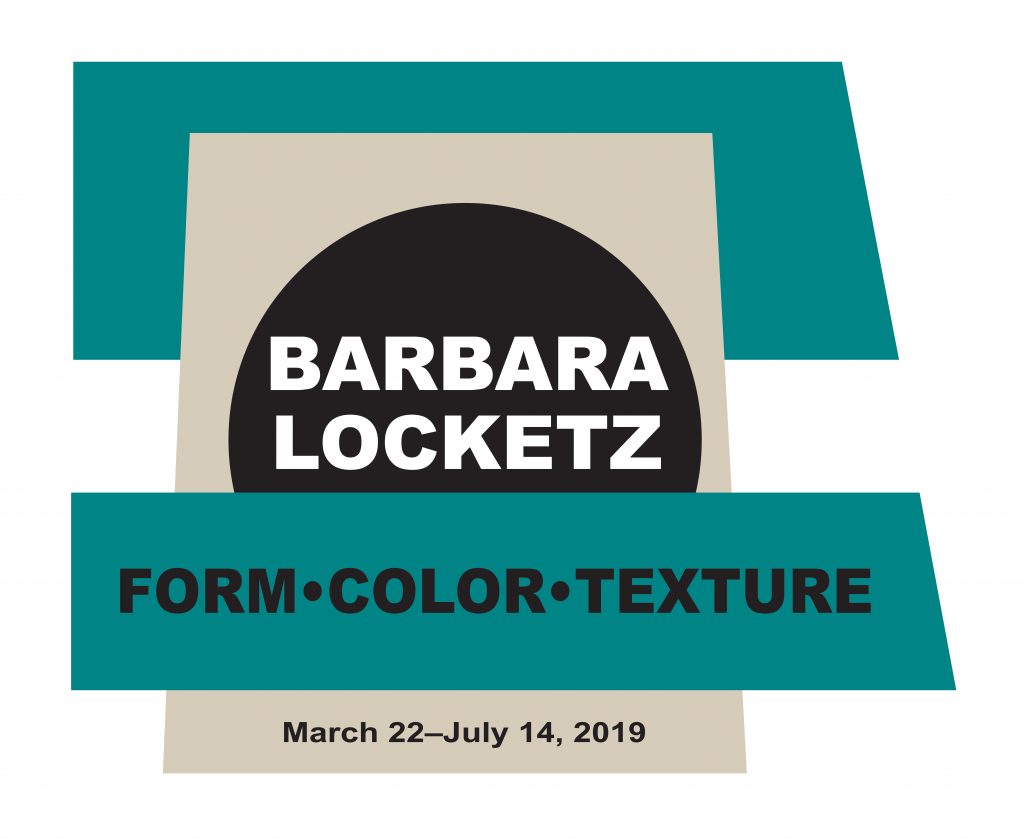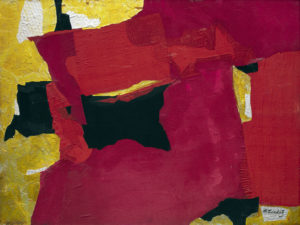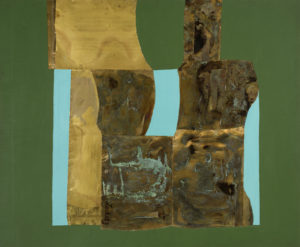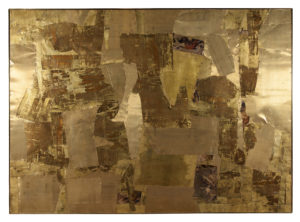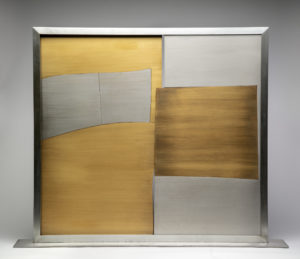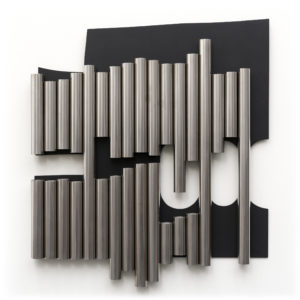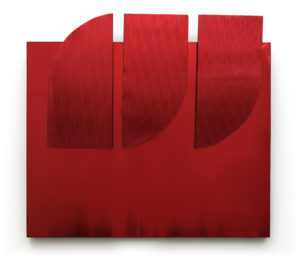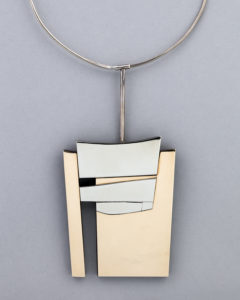March 22–July 14, 2019
On View March 22–July 14, 2019
Co-curated by Hugh Grant, Founding Director, and Christopher Herron, Deputy Curator
A 42-page catalog with essay by Stan Cuba, Associate Consulting Curator, and foreword by Hugh Grant, is available for purchase in our Museum Store ($25.00 while supplies last) or for individual purchase directly from Blurb.com as a softcover book ($35.00 plus shipping), or as a downloadable PDF ($6.00). The catalog text is available below.
EXHIBITION OVERVIEW
Kirkland Museum is pleased to feature a retrospective of Barbara Locketz (1927–2017), whose artworks include oil paintings, prints, paper and metal collage, metal and acrylic sculpture, jewelry and textiles. She was a student of Vance Kirkland while completing her MA at the University of Denver and later taught there from 1964 to 1971. She exhibited her work throughout Colorado and the American Southwest, New York and Mexico.
INDEX
SELECTED IMAGES
-
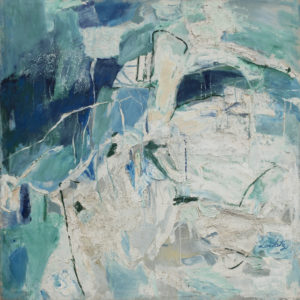
- Isle of Santa Rosa, 1963, oil on canvas, 60 x 60 inches, Collection of Kirkland Museum; Gift of Robert Paley and Tobi Steinberg
-

- Olé, c. 1963, fabric and foil paper collage on canvas, 36 x 48 inches, Collection of Daniel Di Guglielmo
-

- Kyoto, 1965, oil paint and metal collage on wood, 42 x 51 inches, Collection of the Barbara Locketz Estate
-

- Amalgam Limited #7, 1965, metal collage on wood, 42 x 56 inches, Collection of the Colorado Springs Fine Arts Center at Colorado College. Gift of the Denver Art Museum. FA 1991.11.20 Bequest of Vance Kirkland to the Denver Art Museum.
-

- Multiple Variation III, 1967, bronze and stainless steel, 31 1/4 x 33 1/2 x 1 inches, Collection of the Barbara Locketz Estate
-

- Metal Thing M-4, 1969, painted and chromed steel, 25 1/2 x 23 x 1 1/4 inches, Collection of Kirkland Museum
-

- Mexico Red, 1970, metal on wood, 27 1/4 x 29 1/2 x 1 3/4 inches, Collection of Kirkland Museum; Gift of the Artist
-

- 61-4 Pin Pendant, 1967, white and yellow gold on wood, 3 1/2 x 3 x 1/4 inches, Collection of the Barbara Locketz Estate
FOREWORD
by Hugh Grant, Founding Director & Curator, Kirkland Museum of Fine & Decorative Art
Vance Kirkland acquired a wall sculpture by Barbara Locketz the year she created it in 1965. It is an eye-catching, metal collage titled Amalgam Limited #7; large at 42 x 56 inches, and it hung in his house until he died in 1981. At the request of the Denver Art Museum, Vance willed it there. The museum then deaccessioned the work about 1995 to the Colorado Springs Fine Arts Center which is loaning the sculpture to this exhibition.
Barbara and Vance became good friends and they entertained each other as well as many of their DU colleagues including Bob Behrens, Cab Childress, Roger Kotoske, Mary Lanius, Bob Mangold, Warren Morrow, Bev Rosen, Maynard Tischler and David Yeakley. Those are the friends I remember of the Art Gang, as we sometimes referred to our group. Many of them are notable artists and artworks by Behrens, Kotoske, Locketz, Mangold, Morrow, Rosen, Tischler, and Yeakley are now in the collection of Kirkland Museum. I was fortunate enough to be included in some of those get-togethers and that is how I met Barbara. After Vance’s death, the important art critic Michael Paglia and sculptor Robert Delaney were added to our parties, among others.
Locketz earned her MA in painting at the University of Denver (DU) while Vance was director of the School of Art and she participated in classes conducted by Vance. Upon her graduation, he appointed her as a professor there, recognizing her ability as a teacher and as an artist. She then taught in the art department at DU from 1964–1971, under Vance Kirkland’s leadership, until he retired in 1969. Barbara proved to be inspirational to the students, with many sending her notes years later telling her how much they derived from her teaching and personality.
Until her untimely death, Barbara and I continued getting together after Vance’s passing; yes, I know she was 89 years old when she died, but she was extraordinarily entertaining and sparkling until she returned from a trip to Mexico with an infection and passed away. What an analytical mind; what a talent; what a personal loss to me and others!
We shared dinners together numerous times and discussed the “good old days” and current art events. Her memory and captivating personality were something to marvel at. I once asked her about being part of the DU School of Art; she replied “Vance was the DU School of Art, along with the professors he hired!” Barbara also said, “Vance Kirkland got people going in new directions.”
When we went to dinner in later years, I would park nearby so Barbara could use her walker and get into the eatery, where I would have reserved a large table for us. I want to deservedly give tribute to Daniel Di Guglielmo, Dahlia Luna and Joel Luna, her devoted assistants at her residence and elsewhere, who kept her comfortable and safe day after day. We should all be so fortunate to have caring people like this.
One of the most unusual aspects of Barbara’s artworks is that, as she said to me, “I wanted to integrate painting and sculpture.” She did that by creating the flat, two-sided metal sculptures that swivel to reveal both sides; also standing, fixed, relatively flat sculptures. She also did wall sculptures that are sometimes metal, sometimes “plexi wall sculptures” as Barbara termed them, which are very 3-dimensional, and sometimes other materials which are collages. They hang on a wall like a painting, but they are sculptures. And Barbara was an exceptional painter too, using oil on canvas, oil on board and watercolor on paper.
There are 56 works in this exhibition; 7 of which are in the collection of Kirkland Museum and the rest are much appreciated loans. One of the most fascinating things about Barbara’s career is the diversity of the media she used, indicating how adventurous and versatile she was. She excelled at creating paintings, collage, sculpture, jewelry, clothing and prints. This exhibition includes paintings in oil, acrylic, India ink and mixed media; collages incorporating oil paint, paper, fabric and metal; steel, bronze and acrylic sculpture; jewelry made of gold, silver, brass, acrylic, and wood; textile clothing; a ceramic dish and a woodcut.
We are very appreciative to the donors who generously gave us works by Barbara Locketz: Barbara herself and Robert Paley and Tobi Steinberg. We also wish to express our gratitude to our lenders: Philip Atchison, Sherry Baker and Peter Rosen, Colorado Springs Fine Arts Center at Colorado College, the Congdon Family: Tom, Noel and Lucy Congdon Hanson, Daniel Di Guglielmo, Hugh Grant, Annie T. Kao and Peter Q. Murphy, Barbara’s daughters Jan and Leslie Locketz, Peggy and Robert Mangold and a private collection. Thank you to staff at The Shop at the Denver Art Museum for loaning exhibition props.
Those loans and the layout of the exhibition are the impressive work of our Deputy Curator, Christopher Herron, who is Co-curator of this show; he is the ringmaster of all of the efforts that went into organizing this exhibition. Chris also coordinated and edited the photography for the website and catalog and created the logo. Becca Goodrum, Collections Manager, inventoried the incoming works and produced the tags. Becca and Renée Albiston, Curatorial Associate & Outreach Manager, assisted with the loan agreements and image rights. The installation was done by Chris, Becca and Dave Seiler.
The well-researched and insightful essay by Stan Cuba, one of the most accomplished art writers to document Colorado art, chronicles Barbara’s life and career. Stan’s dedication to the subject of Colorado artists and others is admirable.
Maya Wright, Interpretation Manager & Historian at Kirkland Museum, designed the catalog, website and wallboards and kept us all on schedule. Megan Sullivan, Education & Volunteer Services Manager, wrote and presented training sessions for museum staff and volunteers to learn about Locketz, and many other staff helped plan our opening reception and promote the exhibition.
Gerald Horner, Deputy Director, gave me invaluable support. All our capable staff and volunteers, who run Kirkland Museum daily—as well as our members—make it possible for us to put together temporary exhibitions such as this and to survive as a museum. We are also immensely grateful to Merle Chambers Fund for generously providing the funding for our museum building.
Furthering our mission to promote Colorado’s distinguished art history, Barbara Locketz joins 15 other significant Colorado artists who have been featured in special exhibitions at Kirkland Museum since we opened to the public in 2003: William Sanderson; Frank, Kathleen Huffman and Diana Vavra; Edward and Donna Marecak; Vance Kirkland; Jenne and Ethel Magafan; Al and Lou Wynne; William Joseph; Glenn Cuerden; Phyllis Hutchinson Montrose and Elizabeth Yanish Shwayder.
Along with those shows, Kirkland Museum has given 15 group exhibitions featuring Colorado artists: Driven to Abstraction, Modern Clay in Denver, Colorado Abstract Expressionism, 15 Colorado Artists, The Denver Artists Guild, Colorado Abstract and 9 Colorado art surveys.
It was my great hope that Barbara would be alive to see this exhibition. But she knew it was scheduled and we were able to interview and plan the show with her. Barbara’s innovative, imaginative artworks will continue to be proudly shown at Kirkland Museum and the catalog of this exhibition will go on to represent her for many years to come.
BARBARA LOCKETZ—FORM, COLOR AND TEXTURE
by Stan Cuba, Associate Consulting Curator, Kirkland Museum of Fine & Decorative Art
Painter, sculptor, printmaker, jewelry designer, teacher and community activist, Barbara Locketz enjoyed a very absorbing and fulfilling career centered in Denver, Colorado, in the second half of the twentieth century. Initially working in a referentially abstract style in the early 1960s, she soon switched to total abstraction while pursuing her Master of Arts degree at the University of Denver (DU). Her career track evolved from painting and printmaking to collage, sculpture and finally jewelry. A very creative, well-read individual fully conversant with modern art, she successfully experimented with paper, wood, metals and transparent thermoplastics (acrylic/plexiglass/Lucite) achieving bold effects in texture, color and the play of light. In addition to producing a fine and imaginative body of work with an admixture of Abstract Expressionism and Constructivism, she was a devoted teacher to her students and an accomplished gourmet cook.
For more than a decade Locketz participated in annual exhibitions at the Denver Art Museum. She had several solo shows in local art galleries, as well as at DU, the Contemporary Gallery in Dallas, Texas, and the Arvil Gallery in Mexico City. Her work was also chosen for juried shows outside Colorado, including the HemisFair ’68 in San Antonio, Texas; Joslyn Art Museum in Omaha, Nebraska; New Mexico Museum of Art in Santa Fe; Institute of Contemporary Art in Boston, Massachusetts; Tyler Museum of Art in Texas; Oklahoma Art Center in Oklahoma City; Salt Lake Art Center in Utah; Ball State University in Muncie, Indiana, and the Gallery of Galleries in Mexico City. They are barometers of her talent and the acceptance of her work outside of her adopted state, comparing favorably with that being done at the time elsewhere in the country. Her posthumous exhibition at Kirkland Museum of Fine & Decorative Art in Denver offers an opportunity to become acquainted with the various aspects of her artwork. The exhibition also seeks to illuminate her contributions as a teacher and community activist to furthering an understanding and appreciation of modern art at a time when it was not widely accepted in Denver and elsewhere in Colorado.
She was born Barbara Vollwich in 1927 in Maywood, Illinois, an early West Side suburb of Chicago. When she was two years old her family relocated to San Antonio, Texas, whose altitude and warmer climate they felt would benefit her father’s rheumatic heart condition. The city provided her an initial contact with Mexican culture that as an adult exerted a major influence on her creative output as a painter and sculptor.
In the sixth grade her first art creation—a scene constructed in a shoe box of Cinderella and horses going to the ball—earned her a fifty-cent prize. Thrilled by the award, she ran home to share the news with her family. However, as she later recalled, “As a youngster I was not particularly interested in art. I went to the movies on Saturdays and watched cartoons, including Betty Boop.”1 Although she did not draw or paint as a child or young adult—rendering her inborn artistic talent temporarily dormant—she remained conscious of color, form, texture, shadow and composition in what she observed on a day-to-day basis. She later reminisced, “I always wanted to make art but did not quite know how.”2
After her father’s death in Texas when she was twelve years old, her widowed mother relocated the family to Minneapolis, Minnesota, where she had relatives and where she owned and ran the Melody Music Store. Having skipped two grades in high school, Barbara graduated at sixteen and entered the University of Minnesota where she earned a Bachelor of Science degree in child education in 1948. She was encouraged in her course of study by her mother, a good and resourceful businesswoman who understood the value of a steady, income-producing career.
The music store also played an important role in her daughter’s life as the place where as a high school student Barbara met her future husband, Harold Locketz, who frequented the store for its selection of jazz records. In 1947 they spent their honeymoon in Colorado and stayed at the Broadmoor Hotel in Colorado Springs, among other locations, falling in love with the state. Three years later they relocated to Denver from the Midwest with their infant daughter, Leslie, and Jan on the way, so that Harold could do his residency in psychiatry at the University of Colorado Medical School.
In 1954 Barbara and Harold took their first motor trip to Mexico, one of many made with the family by car and later plane. She became enamored with its art, crafts, bright colors, clothes, warmth of the people and their enduring connectionto their history and culture.3 Her acquired love of Mexican culture left an indelible mark on her mature work as an artist, as captured in her painting, The Dance of the Old Men that reflects performances by the Ballet Folklórico de México in Denver in the mid-1960s.
When her husband was drafted into the United States Air Force in 1957 the family moved to Maxwell Air Force Base in Montgomery, Alabama, which Barbara at first thought was “the end of the world,” although later she considered her time there to have been a highlight of her life.4 During the next two years she participated in some of the activities available to the officers’ wives, taking classes in ceramics and painting that brought to the fore her natural artistic talent. Drawing on her pervasive sense of humor, she made a ceramic dish decorated with vignettes of her daily activities collectively titled Life with Barbara. They show her looking into the refrigerator, working at her easel and smoking a cigarette in an evening dress at a function at the Officers’ Club on base.
In the art group of the Officers’ Wives’ Club she studied painting with Montgomery artist, Charles Eugene Shannon (1914–1994), an alumnus of Emory University and a graduate of the Cleveland School of Art [also attended by Vance Kirkland (1904–1981), the namesake of Kirkland Museum of Fine & Decorative Art]. An artist-correspondent for the War Department in the South Pacific during World War II, Shannon showed in juried exhibitions at the Metropolitan and Whitney Museums in New York, Carnegie International in Pittsburgh, Cleveland Museum of Art and the Art Institute of Chicago.
In 1959 Locketz won first prize in Shannon’s figure class for her modernist oil, The Gardener (present location unknown). The subject and style of the painting, which features an eyeless man sitting under a tree, reflect the influence of her teacher, best known for depicting stylized, elongated African American figures in scenes of everyday life in the South. Similar to The Gardener is her extant image of a young seated girl who worked for the Locketz family in Montgomery. Around the same time, always eager to experiment, she placed a seated figure in a referentially-abstract untitled drawing in India ink and gouache. The Lantern, representative of her work in the still-life genre and singled out by the local press for its “delightful movement,” was included in an exhibition of Shannon’s students’ work from the Officers’ Wives’ Club at the Montgomery Museum in April 1959.5
In 1960 Dr. Harold Locketz had a job opportunity in Florida, but Barbara and the children convinced him to move back to Denver. Continuing the course work she started at the University of Alabama, she studied with artists Lyle True (1927–1969) and Frances Frakes Hansen (1915–1998) at Colorado Women’s College (CWC) in 1960–1961.6 They suggested that she complete course work for a Master of Arts degree at the University of Denver whose art department Vance Kirkland had revitalized in 1946, heading it until his retirement in 1969.7
Beginning at DU in the fall semester of 1961 she took painting classes with Kirkland that fostered an increasingly abstract style in her works on canvas in the early 1960s. They are infused with color because, as she liked to say, as an artist she “talked in colors.”8 Her Isle of Santa Rosa, imbued with California light, explores the rocky structure of Santa Rosa Island, part of the Channel Islands offthe coast of Santa Barbara. The painting resulted from a three-week family motor trip from Denver to California in the summer of 1963 that included a coastal drive from Los Angeles to San Francisco with stops along the way. Another untitled canvas painted the same year references a group of red building shapes in an urban setting.
She studied printmaking at DU with John Billmyer (1912–2001), an alumnus of the Kirkland School of Art in Denver, the Cleveland School of Art and Case Western Reserve in Cleveland. She remembered him as “tough but good, making her work hard.” While Billmyer’s student she produced a number of abstract woodcuts, among them And Blue.9 The upward and horizontal movement of the black-and-white and green geometric shapes contrasts with the blue area added as a seeming afterthought conveyed by the woodcut’s title. The orange background of Mexican Fiesta draws on the vibrancy of Mexico’s culture viewed through a centuries-old architectural fragment. In a large woodcut, Red for V.[ance] K.[irkland],10 Locketz expressed her admiration for her former DU painting teacher whose creative energy is symbolized by the color red.
She likewise studied sculpture and basic design with Robert Mangold (b. 1930) whom Kirkland hired for the faculty in 1960.11 Mangold’s curriculum included components from the pre-war German Bauhaus program, focusing on practical formal analysis, particularly on the contrasting properties of forms, color and materials. He stressed a simple, rational, minimalistic, geometrical and functional approach to aesthetics—a modern approach to design and art that influenced Locketz’s approach to her own work.12
In conjunction with studying painting and sculpture at DU, she continued working in the collage medium begun while a student at CWC. According to Mangold, collage provided a natural avenue of exploration for a beginning sculptor because of the opportunity for layering and construction within the finite dimensions of a particular surface. It similarly allowed her to experiment with a variety of materials in different textures, creating form and space in a two-dimensional format.13 Her first noted piece in the medium titled Landscape (1962, present location unknown) drew upon the subject matter of her early referentially-abstract paintings of the Colorado landscape.14 The excitement of a Mexican bull fight is encapsulated in her abstract collage Olé, dominated by the bullfighter’s bright magenta cape partially penetrated by the bull’s black mass.
Collage—along with basic design and drawing—was one of the courses Locketz taught at DU when hired by Vance Kirkland in 1964 after earning her MA degree that year. Informing her students that collage is the “art of assembling and fabricating a painting by gluing or attaching actual materials to a canvas or other surface,” they used papers, fabrics, discarded objects, sand, gravel and other materials to aesthetically create an abstract result.15
Locketz taught many of her drawing, painting and design classes in the converted World War II army barracks near the Engineering Department on the DU campus.16 She introduced her students to abstract art, particularly the abstract expressionists then much in vogue, presenting and discussing images of their work. Her students generally worked abstractly, but she did not downplay those preferring a more classical, representational style.
She had full classes because students liked her teaching methods. Former student William Johnson said of Locketz, “She was the proverbial Jewish mother who took you under her wing.”17 However, she expected a good amount of work from them each semester. She was open to their different ideas, pushing them to do their best. When they asked her how they should proceed with their work she provided sources for them to consult as her sculpture teacher had done with her; but she made the choice theirs because she considered it key to developing and expanding her students’ creativity. She also socialized with them after class, sometimes inviting them to her home where she displayed the art she and her husband collected along with the work she had purchased from talented DU art students.
During her first year of teaching at DU she started doing metal collages, the first step in her fusion of painting and sculpture, since they were meant to be hung on a wall. She said that they and much of her later works “combine a spontaneity occurring during the creative process with an ordered approach to painting and combine the material of the sculptor with the spatial attitude of the painter.”18 Her metal collages were inspired by the copper and brass reliefs which Hungarian-born sculptor Zoltán Kemény began doing in Zurich in the mid-1950s.19
Locketz’s Compound Copper & Brass—like her two-toned metal collages in a group show at the Rubenstein-Serkez Gallery in Denver in 1964—are punctuated by tiny tacks securing the rough-edged, partially-oxidized copper and brass shapes that present a rich contrast in texture, color and the play of light.20 Kyoto exploits the burnished surface of metal to complement flat paint in green and turquoise. Referencing Japan’s ancient cultural capital in the collage’s title, its composition reflects Locketz’s appreciation of Asian aesthetics found in beautiful Japanese textiles.21
She enjoyed using metal for her collages and sculptures because of its tremendous potentialities as a modern art form. For her and other metal sculptors the “intimacy between materials, methods, techniques and ideas…made possible the delineation of moods and feelings which could not be portrayed in traditional sculpture.” The growth of metal sculpture in the decades after World War II not only reflected American willingness to “accept new things and…the absolute relish for startling changes,” but also the relatively low cost of producing a finished work versus one in marble or cast bronze.22
Notwithstanding Locketz’s enjoyment in creating abstract compositions in metal and other media, so-called “non-representational art” did not enjoy wide currency in Denver in the early 1960s. As local journalist Joyce Covey noted, Otto Bach (1909–1990; director of the Denver Art Museum 1944–1974), showed little interest at the time in mounting exhibitions of contemporary artists living and working in Denver and elsewhere in Colorado. Consequently, in September 1965, a group of fifteen artists, collectors and aficionados of contemporary art—including Barbara and Harold Locketz and Robert and Peggy Mangold—met to discuss the situation with Bill and Rena Lifton, owners of the The Gallery in Cherry Creek, resulting in the formation of the Friends of Contemporary Art (FOCA).23
The group, which remained active until the mid-1970s, engaged in a dedicated educational program of lectures and exhibitions fostering the acceptance of contemporary art.24 The organization’s first exhibition, held at The Keep in Denver’s Larimer Square in 1967, featured a group of thirty abstract expressionist works by Robert Rauschenberg, Joan Miró, Kenzo Okada and Elaine de Kooning, among others, from the collection of New York University. To promote it, Locketz created a striking red poster with several cascading geometric shapes like the ones employed in her own sculptures. The success of the exhibition was followed up with a symposium and exhibition of avant-garde artists from the Park Place Gallery of Art Research in New York. Locketz chaired the event during which the Park Place artists participated in a symposium with Denver architects, teachers and artists.25
After the mid-1960s she did a small mini-series, Metal Dimensions, that included both hanging and standing pieces. Notable among the latter is Metal Dimension #1, a beautiful combination of steel and bronze that can be rotated a full 360 degrees on the stem base. It can be viewed as an autobiographical piece in the context of the women’s movement of the 1960s.26 The sculpture has soft textures and curves, symbolic of the artist’s feminine side, combined with harder, edgy lines denoting that she is big, bold and sure of herself in a world not without difficulties and obstacles.
Along with her standing metal sculptures in 1967 she adapted the style of her earlier metal collages to a series of free-standing screens titled Multiple Variations. They are artful combinations of hard-edged, flat geometric shapes rendered in polished metals—steel, bronze and copper—which she pieced together like a puzzle in a fireplace screen, Multiple Variation III. Another of her Multiple Variations was displayed in the garden of HemisFair ’68 in San Antonio, Texas, celebrating the confluence of civilizations in the Americas.27 She was the only Denver artist represented in the fair’s international sculpture section that included Harry Bertoia, Barbara Hepworth, Louise Nevelson, Jacques Lipchitz, Henry Moore, Isamu Noguchi, Pablo Picasso and David Smith, among others. Another variant of her free-standing metal screens has panels sliding horizontally like a Japanese Shōji screen so that when partially open the area behind it becomes part of the whole composition.
Locketz made life-size models of her sculptures at her home on South Hudson Street in Denver, cutting the various metal shapes in cardboard on her dining room table. She entrusted them to be fabricated and assembled at Zimmerman Metals, a third-generation family business founded in Denver in 1936. Construction and finalization of these sculptures was an interactive process between her and the metalworking company. When the occasion presented itself, she would use the sculptures’ creation at her home as a teaching opportunity for her students about composition, structure and line.
In 1968 she created her only limited edition of one of her smallest hanging metal sculptures, Even Dozen, whose title references the twelve pieces of the edition produced in different palettes.28 Employing an identical format for each one, the asymmetrical placement of the geometric shapes is a frieze-like arrangement somewhat reminiscent of the work of artist, Jean (Hans) Arp.29
The following year Locketz did a mini-series with the word “Thing” in the title. It includes the disparate compositions Metal Thing M-4, two tiers of highly polished metal rods on a black background resembling a pipe organ or a roomradiator, and Blue Thing, a large, two-part plexiglass arrangement mounted on a white base that lays on the ground—a unique departure from the balance of her work.
By the late 1960s she also began combining plastics and metal in her hanging sculptures. In preparation she read Thelma R. Newman’s book, Plastics as an Art Form, acquiring important technical information for working in the medium. Plastics—used by a number of post-World War II painters and sculptors such as Helen Frankenthaler, Claes Oldenburg, Henry Moore, Jackson Pollock and David Alfaro Siqueiros—appealed to Locketz because they were representative of the modern world and were capable of going beyond the capacity of the older, more traditional materials of bronze, marble and stone. Lighter and cheaper to produce, plastics also could compete in stability and structural strength.30
Something M-B artfully combines plastic and metal in a hanging sculpture much like one of her jewelry pendants. It was part of her solo show at the Arvil Gallery in Mexico City in 1971 of which author and critic Alfonso de Neuvillate Ortiz wrote: “Within the discipline of beauty, Barbara Locketz’s work offers itself as a solution and a new road to certain sculptural attitudes of reality…From every angle from which they are viewed […her] sculptures are paradigms and finalities, resolutions and unarticulated means of exploiting and exploring the silent worlds of disconcerting presences.”31
Locketz’s long-standing contact with Mexican art and culture inspired a mini-series of hanging plexiglass sculptures such as Mexico Blue & Red whosecircle and oval placement are similar to those in Something M-B, and Mexico Smoke & Silver whose palette of smoky plastic on a metal background alluding to silver Mexican jewelry also appears in her mixed media collage on paper titled Tane, a famous jewelry brand in Mexico since 1948. Although strongly influenced by Mexican art, she consciously avoided using any of its form or content in her own work.
Her contacts with Dallas through friends and exhibitions there likewise account for a similar hanging plexiglass mini-series Dallas in the early 1970s. Dallas Three Reds is a striking combination of geometric shapes whose vertical tier of red rectangles recalls Mark Rothko’s painting, Tan and Black and Red (1957). Dallas Big Blue has a large blue circle on an expansive, horizontally-bisected oval whose peaceful, contemplative quality has an underlying Asian aesthetic.
In 1971 Vance Kirkland’s successor as head of the DU Art Department, Mel Strawn (b. 1929), eliminated the design section staff, ending seven years of devoted teaching there for Barbara Locketz, as well as the positions of Roger Kotoske (1933–2010), Warren Morrow (b. 1940) and other colleagues. Pam Rusch and some of her fellow art students who valued their art teachers met with Chancellor Mitchell to request their reinstatement. When it did not happen, the students protested his decision by not attending graduation that year.32 Locketz’s release from DU was a big emotional blow because she loved teaching and was very attached to her students. She continued to maintain contact with a number of them over the years until her death in 2017. She taught briefly atMetropolitan College in Denver (1976–1977) and Graland School (1984–1985), also conducting docent training at the Denver Art Museum (1979) and a workshop for the Littleton Fine Arts Guild (1980).
By the mid-1970s she stopped doing her large sculptures. The fallout from her dismissal from the DU Art Department became compounded by several other factors: the emotional effect of her divorce in 1974 after twenty-seven years of marriage, the onset of physical maladies during the decade, and her concern for finding full-time employment to ensure her financial well-being.33 An additional deterrent was the material cost of producing larger sculptures, combined with the outlay for their shipment and storage. As a “one-person operation,” she not only had to make her art, but also promote it. Exasperated by her situation, she later jokingly said on more than one occasion, “What am I going to do with all this stuff?—I’ll call Aurora Ash and Trash to come haul it away!”34 Fortunately she did not.
Beginning in 1967 she applied her sculptural talent to creating jewelry. She was encouraged to do so by her long-time friend Carol Steinberg of Denver’s Wilamoro Gallery whose mother, Mrs. Albert List, had turned her attention to artists’ jewelry in her later years after running out of space for paintings and sculptures.35 Locketz also may have been inspired by the strong presence of women sculptors, such as Louise Nevelson and Louise Bourgeois, in the exhibition, Jewelry by Contemporary Painters and Sculptors, organized by the Museum of Modern Art in New York in 1967.
Initially working in gold and silver, Locketz produced pendants adapting her sculpture designs to a miniaturized version.36 In the early 1970s her sculptures likewise formed the basis for the wearable creations she designed in silver and Lucite, a number of which she did in limited editions of 200. Their backing allowed them to function as a pendant or a belt buckle that came with suede belts. According to Mark Timonier, her assistant assembling the pieces for her, they “consisted of a base of plexi with the silver laminated on and then a second piece of plexi that could have silver laminated on it. She had an adhesive that bonded silver to plastic and withstood the polishing process, which she handled. She also had a soft tarnish-resistant pouch made for each piece encased in its own gift box.”37
These silver and Lucite pieces earned her representation in the Sculpture to Wear shop owned by Joan Sonnabend at the Plaza Hotel and the contemporary jewelry gallery, Cul de Sac, at Bloomingale’s in New York, as well as the Electrum Gallery in London.38 In 1972 Time Magazine reproduced her sterling silver and Lucite jewelry in an article about the New Jewelry, numbering in its ranks painters and sculptors such as Alexander Calder, Roy Lichtenstein, Pablo Picasso and Man Ray.39
The following year her creations were included in the Jewelry as Sculpture as Jewelry exhibition presented by the Institute of Contemporary Art in Boston and in a traveling exhibition of the South Central Region of the American Crafts Council honoring the memory of textile artist, Lorraine Gonzalez. That fall Locketz enjoyed further commercial success and local recognition when the Sculpture to Wear collection was shown at The Denver department store in a promotion with Cosmopolitan, “The New Girl of the Golden West is that Cosmopolitan Girl.”40 In addition to exhibiting her jewelry, Locketz conducted a jewelry design seminar during Woman’s Week at Southern Colorado State College in Pueblo in 1974.41
Her strong sense of design likewise extended to her clothing executed by her Denver dressmakers Ruth and later Isabela, such as a black dress with long colored ribbons obtained in Mexico and a dress with Guatemalan accents.Barbara also had clothes made for her daughters and grandchildren. On her trips to New York she loved to shop for unusual and distinctive fabrics with her daughter Jan at Sjoden Gudrum’s store in SoHo. She also purchased distinctive textiles while in Europe, Mexico and Central America. Carol Vincent, a long-time family friend, wrote Locketz on her eighty-ninth birthday, “You always have been an inspiration to be wildly brave in your dress, accessories, cosmetics—always polished and put together.”42
Design and color similarly were manifested in the wooden cubes she devised for the patio of her South Hudson Street home covering them with Mexican tiles and topping them with Mexican pots. Displaying sculptures by Robert Mangold and others, her garden was planted with swaths of bright colors as intense as her artwork and clothing. She adorned the outside walls of her home with her metal collages and stainless-steel sculptures such as Wall Sculpture and Metal Dimension #7.
Along with creating her own art and teaching, her career included community service. As part of FOCA’s mission of promoting contemporary art, she was one of a dozen members of its speakers’ bureau available for slide lectures about art in Europe and America. During Park Place Week in Denver sponsored by FOCA in 1967 she coordinated the studio tours of member artists and was a week-long hostess of the Henry Moore exhibition at the Denver Art Museum where she also gave demonstrations to school children during the Materials and Techniques Exhibition. For the local Jewish Community Center’s book fair in 1966 she designed an attractive bookplate. Four years later she created the large sign-sculpture for the 1st Annual Colorado Art & Environment Multi-Media Exhibition at the American Medical Center at Denver (AMCD), coordinated by artist Angelo di Benedetto (1913–1992), art collector Carol Steinberg and Sebastian Adlerof the Contemporary Art Museum in Houston, Texas. In 1973 she was one of fifteen Colorado artists participating in the Art in the City project, coordinated by Robert Mangold, to upgrade Denver’s drab traffic isles with sculptures.43
Barbara Locketz was an artist who constantly explored the nature of art with new materials and ideas calling out to her attention. Possessing an innate, unflagging curiosity, she traveled elsewhere in America and to Mexico and Europe to see what people were doing and creating. Everything interested her, whether the annual Documenta exhibit in Germany, the Venice Biennale, modern sculpture at the Kröller–Müller Museum famous for its sculpture garden in Otterlo, Netherlands (all of which she visited), or distinctive hand-painted pottery in the Italian hill towns and folk crafts in Mexico, Guatemala and Costa Rica. In one way or another all of them contributed to her reservoir of inspiration and talent. A proponent of non-objective art, she never felt that it should be mysterious because, as a teacher, she believed that part of an artist’s job is to engage and talk to viewers, providing insights into the creative process. She considered sculpture the best vehicle to foster the real-time dialog between art, artist and the viewer. The totality of her own creative output in the various media in which she worked “expresses the goal that beauty, proportion and function should become such an integral part of life that art becomes indistinguishable from existence.”44
The foregoing essay is based on the material in Barbara Locketz’s scrapbooks, augmented by the author’s interviews with her and her daughters, Leslie and Jan Locketz, as well as with sculptor Robert Mangold, students Pam Rusch and William Johnson, longtime friends John Parrott and Peter Murphy and caregiver Daniel Di Guglielmo.
ABOUT THE AUTHOR
A graduate of Columbia University in New York, Stan Cuba is Associate Consulting Curator of Kirkland Museum of Fine & Decorative Art in Denver. He has written The Denver Artists Guild: Its Founding Members, An Illustrated History; John F. Carlson and the Artists of the Broadmoor Academy; and coauthored Sandzén in Colorado; Good Impressions: American Master Prints of the 1920s, ‘30s and ‘40s from the Collection of Frederick and Jan Mayer; The Art of Charles Partridge Adams; The Colorado Book; Pikes Peak Vision: The Broadmoor Art Academy, 1919–1845; and George Luks: An American Artist. He has curated and written the catalogs for the regional art exhibitions Olive Rush: A Hoosier Artist in New Mexico; Józef Bakoś: An Early Modernist; Colorado Women Artists, 1859–1950; and Hayes Lyon: A Colorado Regionalist. He has published in American Art Quarterly, American Art Review; El Palacio, Southwest Art; Art of the West; Western Art Digest; Artists of the Rockies and the Golden West; Taos Magazine; Colorado Heritage; and Essays and Monographs in Colorado History.
ENDNOTES
1Author’s interview with Barbara Locketz, May 16, 2016, accompanied by Kirkland Museum Founding Director & Curator, Hugh Grant (hereinafter BLI). Betty Boop is an animated cartoon character created by Max Fleischer that became a cultural icon in the 1930s.
2BLI.
3Information courtesy Leslie Locketz.
4Jan Locketz email to the author, February 12, 2019.
5The Lantern is specifically mentioned in an unidentified newspaper clipping about a new exhibition, held at the Montgomery Museum, of the work of Maxwell Air Force Base Officers’ Wives, on view until the end of April, Locketz Scrapbook 1 [hereinafter LS]. The Gardener is reproduced in another unidentified newspaper clipping, LS. Locketz also painted wall murals in the Fledgling Hangar sponsored by the Officers’ Wives’ Club At Maxwell Air Force Base in Montgomery, Alabama.
6Colorado Women’s College (CSC), opened in Denver in 1909 as a private Baptist college for women, was renamed Temple Buell College in 1967 in honor of the local philanthropist’s substantial financial gift in 1966. The college merged with DU in 1982. Nineteen years later the original CWC campus became the Denver campus of Johnson and Wales University.
7In the summer of 1961, before beginning the fall semester at DU, she won first and second prizes at the Colorado State Fair Art Exhibition in Pueblo in the student category for watercolors, drawings and pastels.
8Leslie and Jan Locketz interview, October 22, 2018.
9In 1964 Locketz showed And Blue in the Own Your Own exhibition at Southern Colorado State College in Pueblo.
10Locketz’s woodcut, Red for V.K., was included in the 9th Annual Exhibition, University of North Dakota at Grand Forks (1965), and in the Great Plains Exhibition at Nebraska Wesleyan University at Lincoln (1966).
11Robert Mangold and his wife came to Colorado in the summer of 1960 to attend the Design Conference in Aspen when they became enamored of the state and decided to relocate to Denver.
12Robert Mangold interview, November 30, 2018. For a discussion of Robert Mangold’s work and career, see John B. Woodward III, Realities of Motion: The Sculptures of Robert Mangold. Denver: AB Hirschfeld Press, 1959.
13One of Locketz’s earliest collages, Texture (present location unknown), was accepted for the Denver Art Museum’s Fourteenth Denver Metropolitan Exhibition held in November–December 1962 and juried by Alden F. Megrew (1908–1987), Chairman of the Fine Arts Department at the University of Colorado at Boulder after World War II. Texture also was reproduced on the cover of the invitation to her graduate exhibition of paintings held at DU, February 16–March 2, 1964.
14Locketz’s collage, Landscape, is noted as No. 54 in the catalog, Thirteenth Denver Metropolitan Exhibition, Denver Art Museum, December 10, 1961–January 7, 1962.
15“Collage Artists Use Glue in Work,” Rocky Mountain News (hereinafter RMN), November 28, 1964, 36. Before teaching at DU Locketz taught at the Jewish Community Center in Denver.
16The discussion about Locketz’s teaching at DU is largely based on the William Johnson interview, December 12, 2018.
17Johnson.
18Barbara Haddad, “Denver Museum’s ‘Western Annual,’ Features Colorado, California Artists,” Denver Post (hereinafter DP) “Roundup,” August 14, 1966, 12.
19Zoltán Kemény (1907–1965; Swiss, born Hungary), sculptor of dramatic metal reliefs who received first prize in sculpture at the 1964 Venice Biennale.
20The Rubenstein-Serkez Gallery group show (December 1964) included Locketz’s fellow artists from Denver and Colorado Springs: Louise Cadillac, Dorthea Dunlop, Kenneth Goehring, Frances Oliverius and Elizabeth Yanish. Started in 1963, the short-lived gallery was located at 248 Fillmore Street in Denver’s Cherry Creek neighborhood.
21Locketz had several books on Japanese art including Charles C. Terry, ed., Masterworks of Japanese Art. Rutland, VT, and Tokyo: Charles E. Tuttle Co., 1959; and Donald Richie, intro., Katachi: Japanese Pattern and Design in Wood, Paper and Clay. New York: Harry N. Abrams, Inc., 1964. The Kyoto collage was shown in the Collectors’ Mart at the Jewish Community Center in Denver in 1965.
22John Lynch, Metal Sculpture: New Forms, New Techniques. New York: Viking Press, 1974; in Locketz’s private art library.
23Joyce Covey, “Lincoln Towers Show: ‘Friends’ to Present 8 Artists,” Cervi’s Rocky Mountain Journal, March 29, 1967, 18. FOCA initially was headed by Denver resident Carol Steinberg, a nationally-known collector of contemporary art, and Robert Graham, head of adult education at Colorado University Extension. Locketz’s husband later served as the group’s president.
24In 1972 FOCA published a folio of prints by Gene Davis, Michael Balog and Richard Anuszkiewicz as a fundraiser for the organization. Duncan Pollock, “FOCA May Turn Back Clock: Friends in Trouble?,” RMN, June 24, 1973, LS.
25The exhibition of the Park Place artists was held at Lincoln Towers, East 19th Avenue and Lincoln Streets, Denver. The symposium topics were “Fulfillment of the Functions of Art” and “The Significance of the New Space,” Covey.
26Interpretation of Metal Dimension #1 courtesy John Parrott interview, December 11, 2018. Locketz’s Metal Dimension #12 (similar to #1) was recommended for purchase from the 3rd Intermountain Biennial of Painting & Sculpture in Salt Lake City (1967). Her rotatable Metal Dimensions sculptures were also part of a group show in March 1967 at The Gallery in Denver that included local contemporary artists Barchilon, Eades, Gilbert, Kotoske, Mangold, Matthews, Reiss, Sampson, Smith, Snyder, Vogel and Woodman. Barbara Haddad, “Sacred, Secular Featured in Exhibits,” DP “Roundup,” March 26, 1967, 19.
27A Multiple Variation was shown in the DU Art Department faculty exhibition at the Denver Art Museum, September 30–November 3, 1968.
28Even Dozen was shown in the 1st Icasals Juried Competition at the West Texas Museum in Lubbock in 1969.
29Arp (1886–1966; French, born Germany [Alsace]). When Germany returned the Alsace region to France at the end of World War 1, Arp’s name became Jean under French law, but he continued to refer to himself as Hans when speaking German.
30Discussion based on Thelma R. Newman, Plastics as an Art Form. Philadelphia & New York: Chilton Book Co., 1964, 5-8; in Locketz’s private art library.
31“The Sculptures of Barbara Locketz: Forms of the New,” El Heraldo de México, 1971, LS. Her exhibition in Mexico City was facilitated by Mexican artist, Feliciano Béjar (1920–2007), who exhibited in Denver in the mid-1960s.
32Pam Rusch interview, November 18, 2018. For her, Locketz was not only a professor and mentor, but also like a second mother.
33BLI and Leslie Locketz. After DU Locketz worked at Ocular Printing (1981–1984) and the DU College of Law (1985–1993).
34BLI.
35Martine Newby Haspeslagh, “Introduction,” The Sculptress Adorns: Jewellery [sic] by Women Artists, exhibition catalog, Didier, Ltd., London, 2012.
36In October 1968 Locketz participated in an exhibition of jewelry designed by European and American artists held at Pace Jewelers in the Denver Hilton Hotel, among whom were Louise Nevelson and Jacques Lipchitz, as well as fellow Colorado artists Angelo di Benedetto and Robert Mangold. Barbara Haddad, “Shaffer’s Art on Exhibit,” DP, October 11, 1968, LS.
37Mark Timonier email to the author, January 23, 2019.
38“They Take a Shine to Her Jewelry,” RMN, December 29, 1972, 64. Other venues for Locketz’s jewelry were Marshall Field’s in Chicago, Sam Fredericks in Palm Beach, Florida, and the Wilamoro Gallery and the Brena Gallery in Denver. She humorously described her jewelry-making enterprise as a “tax write off.”
39“Jewelry Back to Design,” Time, December 18, 1972, 64.
40Rena Andrews, “Sculptured Jewelry Shown,” unidentified Denver newspaper clipping, September 29, 1973, LS.
41The Woman’s Week program was coordinated by Women in Art, an organization of women students and faculty members at Southern Colorado State College in Pueblo. “Women in Art Seminar: A Week for Women at SCSC,” unidentified Pueblo newspaper clipping, 1974, LS. In later years Locketz used rare turquoise she found in envelopes in her home desk drawer to design jewelry for her daughters, their husbands and children that was created by William Gray, owner of Anjevine Custom Jewelry in Denver. Leslie and Jan Locketz, January 4, 2019.
42Carol Vincent, “Wish Barb a Happy Birthday,” email to Leslie Locketz, December 6, 2016. Like Pam Rusch, Vincent regarded Barbara Locketz as a second mom.
43Joanne Ditmer, “Raising the Roof: New Art Concept Beautifying the City,” DP, July 28, 1973, 29; Rena Andrews, “’Art in City’ to Turn Drab Traffic Isles into Colorful Oases,” DP, July 29, 1973, 45; “Museum Hostess of the Week: She’s a Sculptor in Own Right,” RMN, June 14, 1967, 66.
44“Contemporary Has Locketz Sculpture,” Dallas Morning News, October 10, 1971, LS—a review of her solo show at the Contemporary Gallery in Dallas, Texas.
LIST OF EXHIBITIONS AND COLLECTIONS
Exhibitions Featuring Barbara Locketz
- University of Denver, Colorado (1964)
- Red Door Gallery, Pueblo, Colorado (1965)
- Southern Colorado State College, Pueblo (1966, with Beverly Rosen)
- The Gallery, Denver (1966, 1967, 1969)
- Contemporary Gallery, Dallas, Texas (1967, 1971)
- Arvil Gallery, Mexico City, Mexico (1971)
- Friends of Contemporary Art, Denver (1971)
- Brena Gallery, Denver (1982; 1988 Two Person Show)
Group Exhibitions
- Art Exhibition of the Maxwell Air Force Base Officers’ Wives’ Club, Montgomery Museum of Fine Arts, Alabama (1959)
- Art Exhibition, Colorado State Fair, Pueblo, Colorado (1961)
- Annual Denver Metropolitan Exhibition, Denver Art Museum (13th–1961; 14th–1962; 16th–1964)
- Annual Invitational Art Exhibition, Pueblo College/Southern Colorado State College, Pueblo (2nd–1961; 4th–1965)
- 1st Annual Winter Carnival Art Exhibition, Leadville, Colorado (1962)
- Denver Museum art exhibitions (1961–1970)
- Fine Arts Festival – Intercollegiate Art Show, Pueblo College, Colorado (1963)
- Gilpin County Arts Association, Central City, Colorado (16th Annual–1963; 18th–1965; 25th Anniversary Exhibition–1972)
- Christmas Show, Rubenstein-Serkez Gallery, Denver (1963)
- Annual Collectors’ Mart, Jewish Community Center, Denver (2nd–1963; 4th–1965)
- Own Your Own Exhibition, Denver Art Museum (1964; 13th–1969)
- Annual Own Your Own Exhibition, Southern Colorado State College, Pueblo (4th –1964; 5th–1965, 6th–1966; 8th–1968, 9th–1969)
- Rubenstein-Serkez Gallery, Denver (1964–Honorable Mention, with Louise Cadillac, Dorothea Dunlap, Kenneth Goehring, Frances Oliverius and Elizabeth Yanish)
- Annual Blossom Festival Exhibition, Fine Arts Center, Canon City, Colorado (17th –1964; 18th–1965; 25th–1972)
- 9 ND National Print and Sculpture Exhibition, University of North Dakota (1965)
- Alumnae Invitational Show—Painting, Drawing, Sculpture, Colorado Women’s College, Denver (1965, with Penny Goss, Juanita Hallam and Susan Hazeltine)
- Exhibition IV, Broadmoor Community Church, Colorado Springs (1965)
- Prints, Drawings and Collages, Rubenstein-Serkez Gallery, Denver (1965, with Watson Bidwell, Mary Chenoweth, Roland Detre and Karl Walter)
- Intermountain Biennial of Painting and Sculpture, Salt Lake Art Center, Salt Lake City, Utah (2nd–1965, 3rd–1967, 4th–1969)
- 1st Annual For the Love of Art, International House, Denver (1965)
- The University and the Fine Arts, Nebraska Wesleyan University, Lincoln (1966)
- 72nd Western Annual, Denver Art Museum (1966)
- Juried Arts Third National Exhibition, Tyler, Texas (1966)
- 8 State Exhibition of Painting and Sculpture, Oklahoma Art Center, Oklahoma City (7th–1965, 9th–1967, 11th–1969)
- Sculpture Exhibition, HemisFair, San Antonio, Texas (1968)
- FOCA Multiple Benefit Show, Tudor Gallery, Denver (1968)
- Pace Jewelers–Hilton Hotel, Denver (1968)
- 1st ICASALS Juried Competition, Texas Technological College, Lubbock (1969)
- 15th Annual Drawing and Small Sculpture Exhibition, Ball State University, Muncie, Indiana (1969)
- Faculty Exhibition, Denver Art Museum (1969)
- New Directions, The Gallery, Denver (1969)
- 11th Midwest Biennial, Joslyn Art Museum, Omaha, Nebraska (1970)
- 46th Annual National Art Exhibition, Springvale Museum of Art, Utah (1970)
- 1970 Southwest Fine Arts Biennial, New Mexico Museum of Art, Santa Fe (1970)
- Colorado Art and Environment Exhibition, American Medical Center, Denver (1970)
- 12 Red River Annual, Red River Art Center, Moorhead Art Center, Minnesota (1971)
- Steinberg Print Collection Exhibition, Metropolitan State College, Denver (1971)
- Brena Gallery, Denver (1971, 1972)
- Multiples Exhibition, Williamoro Gallery, Denver (1971, 1972)
- Gallery of Galleries, Mexico City (1972)
- Friends of Contemporary Art, Denver (1972)
- South Central Exhibition–American Crafts Council, Denver Art Museum (1973)
- Sculpture to Wear, Plaza Hotel, New York (1973)
- Two-Year Traveling Exhibition–American Crafts Council (1973–1975)
- Benson Gallery,Long Island, New York (1973)
- Traffic Island Project–Art in the City, May Company, Denver (1973)
- Sculpture to Wear, The Denver [Denver Dry Goods Company] (1973)
- Sculpture to Wear, Institute of Contemporary Art, Boston, Massachusetts (1973)
- Image Gallery, Dayton, Ohio (1973)
- Metropolitan State College Faculty Exhibition, Denver (1977)
- Selections from the Permanent Collection, Denver Art Museum (1977)
- Ten for Ten, Brena Gallery, Denver (1981)
- Colorado Art Survey, Kirkland Museum of Fine & Decorative Art, Denver (2010)
- The Big Picture, Z Art Department, Denver (2012)
- Colorado Women in Abstraction, Center for Visual Art, Denver (2015)
Selected Collections
- Colorado Springs Fine Art Center
- Southern Colorado State College, Pueblo
- Kirkland Museum of Fine & Decorative Art, Denver
